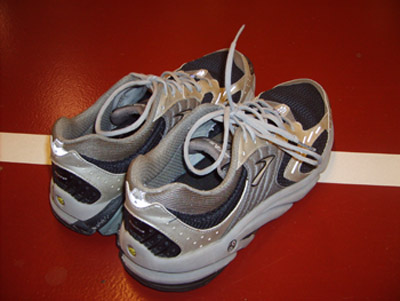Running Shoe Life

The trick is to know when your shoes are in need of being replaced due to being old and worn out. One thing to know for sure, do not use the treads on the bottom of the shoe as a barometer of wear or to determine whether you should replace your shoes. The midsole of the shoe, which provides nearly all the cushioning and stability, usually breaks down before the bottom tread shows major signs of wear. If you have been feeling muscle fatigue, perhaps shin splints, or some other pain in your joints, especially your knees, you may be training in running shoes that no longer have adequate cushioning or stability left in the midsole.
The general rule of thumb is to replace your running shoes every 300 to 400 miles. However, this is dependent on your running style, body weight, and the surface on which you run. Lighter weight runners are typically able to push this recommendation toward the upper limit, while heavier runners should consider replacement shoes closer to the 300-mile mark. If you consistently train on asphalt roads or concrete sidewalks, you will need to replace your running shoes sooner than if you primarily run on a treadmill.
When it is time to buy new running shoes, I would highly recommend you get them at a running specialty shop, as opposed to a “big box” sports shop. A proper assessment of your foot type will ensure a great fit and help you obtain the best shoe for you. Ignore the advertising and listen to a professional with years of experience in fitting and selling running shoes. Once purchased, mark your calendar or in your training log when you buy a new pair of running shoes so you can remember when to replace them. Try to be aware of the number of miles you have run in the new pair. I have also known runners that will write the purchase date on the inside of each shoe in permanent ink in order to remember when they first started running in them.
About halfway through the life of your running shoes (i.e., 150 – 200 miles), you might want to buy another pair of running shoes to rotate into your runs. Each pair of shoes will last longer if you fully allow the midsole material to decompress and dry out between workouts. This is especially true for heavy sweaters or for summer running. Additionally, having a fresh pair of shoes as a reference will help you notice when your older ones are nearing the end of their usefulness.
Although you should replace your shoes every 300 to 400 miles, there are some simple ways to get yourself toward the higher end of that range. The following tips should make your running shoes last longer:
- Wear your running shoes only for exercise. For many people, their running shoes may be their most comfortable pair of shoes, but do not wear them for anything but your training. Even you are just walking around; you are still wearing out the cushioning and the midsole material.
- Take your running shoes off and put them on properly. When we are in a rush, it is easy to take your running shoes on and off without undoing the laces. Make sure you loosen the laces before you put your shoes on and take them off. This also ensures a snug fit and you are less likely to have laces come untied.
- Dry your wet running shoes properly. If your running shoes get wet from either rain or sweat, do not put them on direct heat. Heat dries out and cracks the leather and other materials in the shoes, which will shorten their life span. To dry your running shoes properly, loosen the laces, take out the insoles, and let them air dry, away from direct heat. One trick that is very effective, is to crumple up newspaper and shove it up into the shoes.
- Consider alternating running shoes. If you run almost every day, it may be beneficial to rotate two pairs of running shoes. Your shoes will last longer when you give them a day or two to decompress and fully dry out between workouts.
- Store your shoes properly. Keep your shoes in a cool, dry place where they can air out properly. Do not leave them in a sealed gym bag or your car trunk.
- Never put your running shoes in the washing machine. If you do need to clean your shoes, use a scrub brush, mild soap, and cold water, and then let them fully air dry away from direct heat.
By following these tips, your shoes will last longer in turn saving you money. Additionally you will reduce your risk of developing a training injury allowing you to train longer and more often to meet your running goals.
For more information:
Go to the Healthy Weight Center health topic.